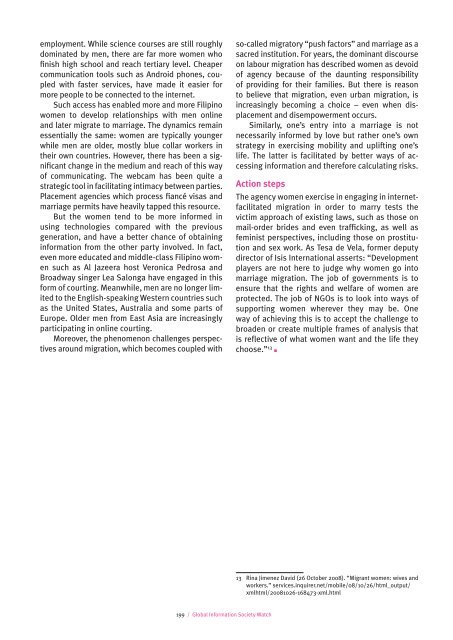gisw13_chapters
gisw13_chapters
gisw13_chapters
Create successful ePaper yourself
Turn your PDF publications into a flip-book with our unique Google optimized e-Paper software.
employment. While science courses are still roughlydominated by men, there are far more women whofinish high school and reach tertiary level. Cheapercommunication tools such as Android phones, coupledwith faster services, have made it easier formore people to be connected to the internet.Such access has enabled more and more Filipinowomen to develop relationships with men onlineand later migrate to marriage. The dynamics remainessentially the same: women are typically youngerwhile men are older, mostly blue collar workers intheir own countries. However, there has been a significantchange in the medium and reach of this wayof communicating. The webcam has been quite astrategic tool in facilitating intimacy between parties.Placement agencies which process fiancé visas andmarriage permits have heavily tapped this resource.But the women tend to be more informed inusing technologies compared with the previousgeneration, and have a better chance of obtaininginformation from the other party involved. In fact,even more educated and middle-class Filipino womensuch as Al Jazeera host Veronica Pedrosa andBroadway singer Lea Salonga have engaged in thisform of courting. Meanwhile, men are no longer limitedto the English-speaking Western countries suchas the United States, Australia and some parts ofEurope. Older men from East Asia are increasinglyparticipating in online courting.Moreover, the phenomenon challenges perspectivesaround migration, which becomes coupled withso-called migratory “push factors” and marriage as asacred institution. For years, the dominant discourseon labour migration has described women as devoidof agency because of the daunting responsibilityof providing for their families. But there is reasonto believe that migration, even urban migration, isincreasingly becoming a choice – even when displacementand disempowerment occurs.Similarly, one’s entry into a marriage is notnecessarily informed by love but rather one’s ownstrategy in exercising mobility and uplifting one’slife. The latter is facilitated by better ways of accessinginformation and therefore calculating risks.Action stepsThe agency women exercise in engaging in internetfacilitatedmigration in order to marry tests thevictim approach of existing laws, such as those onmail-order brides and even trafficking, as well asfeminist perspectives, including those on prostitutionand sex work. As Tesa de Vela, former deputydirector of Isis International asserts: “Developmentplayers are not here to judge why women go intomarriage migration. The job of governments is toensure that the rights and welfare of women areprotected. The job of NGOs is to look into ways ofsupporting women wherever they may be. Oneway of achieving this is to accept the challenge tobroaden or create multiple frames of analysis thatis reflective of what women want and the life theychoose.” 13 ■13 Rina Jimenez David (26 October 2008). “Migrant women: wives andworkers.” services.inquirer.net/mobile/08/10/26/html_output/xmlhtml/20081026-168473-xml.html199 / Global Information Society Watch


